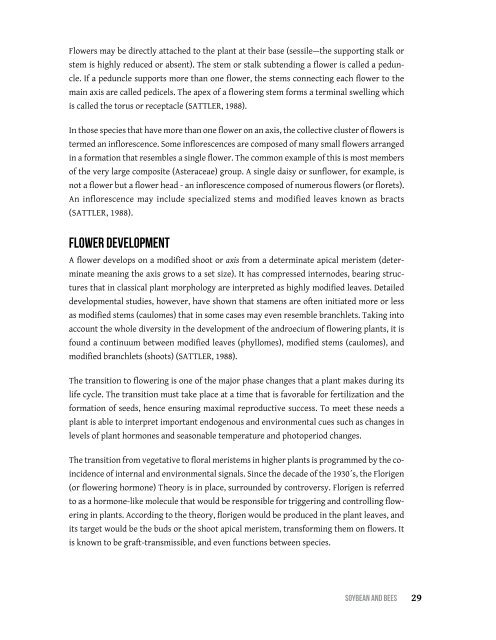Soybean and Bees
Create successful ePaper yourself
Turn your PDF publications into a flip-book with our unique Google optimized e-Paper software.
Flowers may be directly attached to the plant at their base (sessile—the supporting stalk or<br />
stem is highly reduced or absent). The stem or stalk subtending a flower is called a peduncle.<br />
If a peduncle supports more than one flower, the stems connecting each flower to the<br />
main axis are called pedicels. The apex of a flowering stem forms a terminal swelling which<br />
is called the torus or receptacle (Sattler, 1988).<br />
In those species that have more than one flower on an axis, the collective cluster of flowers is<br />
termed an inflorescence. Some inflorescences are composed of many small flowers arranged<br />
in a formation that resembles a single flower. The common example of this is most members<br />
of the very large composite (Asteraceae) group. A single daisy or sunflower, for example, is<br />
not a flower but a flower head - an inflorescence composed of numerous flowers (or florets).<br />
An inflorescence may include specialized stems <strong>and</strong> modified leaves known as bracts<br />
(Sattler, 1988).<br />
Flower development<br />
A flower develops on a modified shoot or axis from a determinate apical meristem (determinate<br />
meaning the axis grows to a set size). It has compressed internodes, bearing structures<br />
that in classical plant morphology are interpreted as highly modified leaves. Detailed<br />
developmental studies, however, have shown that stamens are often initiated more or less<br />
as modified stems (caulomes) that in some cases may even resemble branchlets. Taking into<br />
account the whole diversity in the development of the <strong>and</strong>roecium of flowering plants, it is<br />
found a continuum between modified leaves (phyllomes), modified stems (caulomes), <strong>and</strong><br />
modified branchlets (shoots) (Sattler, 1988).<br />
The transition to flowering is one of the major phase changes that a plant makes during its<br />
life cycle. The transition must take place at a time that is favorable for fertilization <strong>and</strong> the<br />
formation of seeds, hence ensuring maximal reproductive success. To meet these needs a<br />
plant is able to interpret important endogenous <strong>and</strong> environmental cues such as changes in<br />
levels of plant hormones <strong>and</strong> seasonable temperature <strong>and</strong> photoperiod changes.<br />
The transition from vegetative to floral meristems in higher plants is programmed by the coincidence<br />
of internal <strong>and</strong> environmental signals. Since the decade of the 1930´s, the Florigen<br />
(or flowering hormone) Theory is in place, surrounded by controversy. Florigen is referred<br />
to as a hormone-like molecule that would be responsible for triggering <strong>and</strong> controlling flowering<br />
in plants. According to the theory, florigen would be produced in the plant leaves, <strong>and</strong><br />
its target would be the buds or the shoot apical meristem, transforming them on flowers. It<br />
is known to be graft-transmissible, <strong>and</strong> even functions between species.<br />
SoybeAn <strong>and</strong> bees<br />
29


